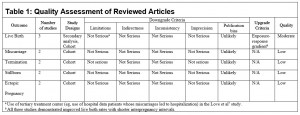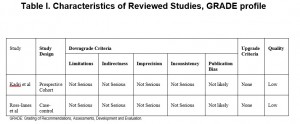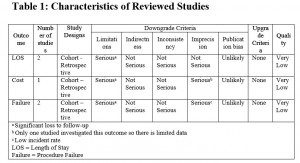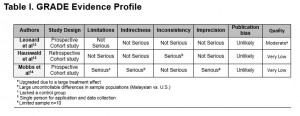Waist-To-Hip Ratio vs. Body Mass Index as a Predictor of Total Mortality for People with Normal Weight and Central Obesity ABSTRACT Background: Obesity has become one of the greatest health risks in the U.S. Obesity is one of the largest causes of mortality in the country leading to the development of cardiovascular disease, liver disease, […]
You are browsing archives for
Category: Graduate Project
Katherine Volk: Interpregnancy Interval ...
Interpregnancy Interval after Miscarriage: Less than Six Months vs. Greater than Six Months ABSTRACT Background: After a woman experiences a pregnancy loss she often asks her clinician for recommendations on when to try conceiving again. Current recommendations to wait 6 or more months may not coincide with the woman’s reproductive desires. Several studies have looked […]
Jacob Wheeler: Modified Valsalva Maneuve...
Modified Valsalva Maneuver vs. Standard Valsalva Maneuver on Emergency Department Patients Presenting with Supraventricular Tachycardia ABSTRACT Background: Supraventricular tachycardia (SVT) is a relatively common dysrhythmia among the general population and a common dysrhythmia presenting to the emergency department. Generally speaking, it is assumed the provider should attempt a vagal maneuver as first-line treatment for SVT, […]
Kyle Saxe: Screening Patients for Barret...
Screening Patients for Barrett’s Esophagus with Cytosponge Coupled with Trefoil Factor 3 Expression Compared to Endoscopy ABSTRACT Background: Esophageal adenocarcinoma (EAC) accounts for an estimated 15 690 deaths in the US each year. The 5-year mortality is 80% unless the disease is caught early. Barrett’s esophagus (BE) is the primary risk for developing EAC, therefore, […]
Kacie Hamreus: Loop Drainage of Subcutan...
Loop Drainage of Subcutaneous Abscesses in Pediatric Patients ABSTRACT Background: Subcutaneous abscesses are increasingly common among the pediatric population in the United States. They require drainage as a means of treatment, as antibiotics alone cannot resolve the infection. The current standard of care is open incision and drainage, which often requires packing the open wound with […]
Ashley Tarantino: Allergies to Staple Fo...
Allergies to Staple Foods and the Financial Burden on Households ABSTRACT Background: Allergies are defined as a rise in allergen-specific IgE plus symptoms. If only a rise in IgE is present then this indicates that the individual has become sensitized to the food, but this elevation does not mean there will be an allergic reaction […]
Alex Kaplun: The Efficacy of Dietary Su...
The Efficacy of Dietary Supplementation with Cocoa to Improve Cognitive Function in Adults ABSTRACT Background: Cocoa is a product of processing of the cocoa bean. It is rich in flavanols, a subgroup of flavonoids, a common compound in plants. Cocoa flavanols have positive effect on the cardiovascular system. Cognitive effects of these compounds have been […]
Joshua Burns: Yoga for Post Traumatic St...
Yoga for Post Traumatic Stress Disorder in Women ABSTRACT Background: Post traumatic stress disorder (PTSD) is an increasingly common disorder with many co-morbid conditions affecting approximately 10 million women in the United States. Current available treatments for PTSD include pharmacologic agents and psychotherapy with varying efficacy. Methods: An exhaustive literature search was conducted using MEDLINE-Ovid, […]
Kelly Wright: Higher Rates of Undiagnose...
Higher Rates of Undiagnosed Bladder Cancer in Women Due to Misdiagnosis as Urinary Tract Infection ABSTRACT Background: Bladder cancer is the seventh-leading cause of cancer-related deaths in the US. Presenting signs include hematuria and irritative voiding symptoms including dysuria and frequency. Formal evaluation includes cystoscopy, upper tract imaging, cytology, and urine culture. There is no […]
Michael Duncan: Spinal Immobilization Ad...
Spinal Immobilization Adverse Effects vs. Benefits in the Trauma Patient ABSTRACT Background: Spinal Immobilization is a standard practice of preventing further injury to trauma patients with suspected severe spinal injuries. Clinical providers employ spinal immobilization devices as soon as traumatic spinal injuries are suspected. The use of spinal immobilization devices is not benign and can cause […]










